Market Overview
The Global
Fitness Apparel Market is projected to reach
USD 297.0 billion in 2025 and grow at a compound annual
growth rate of 7.3% from there until 2034 to reach a
value of USD 558.5 billion.
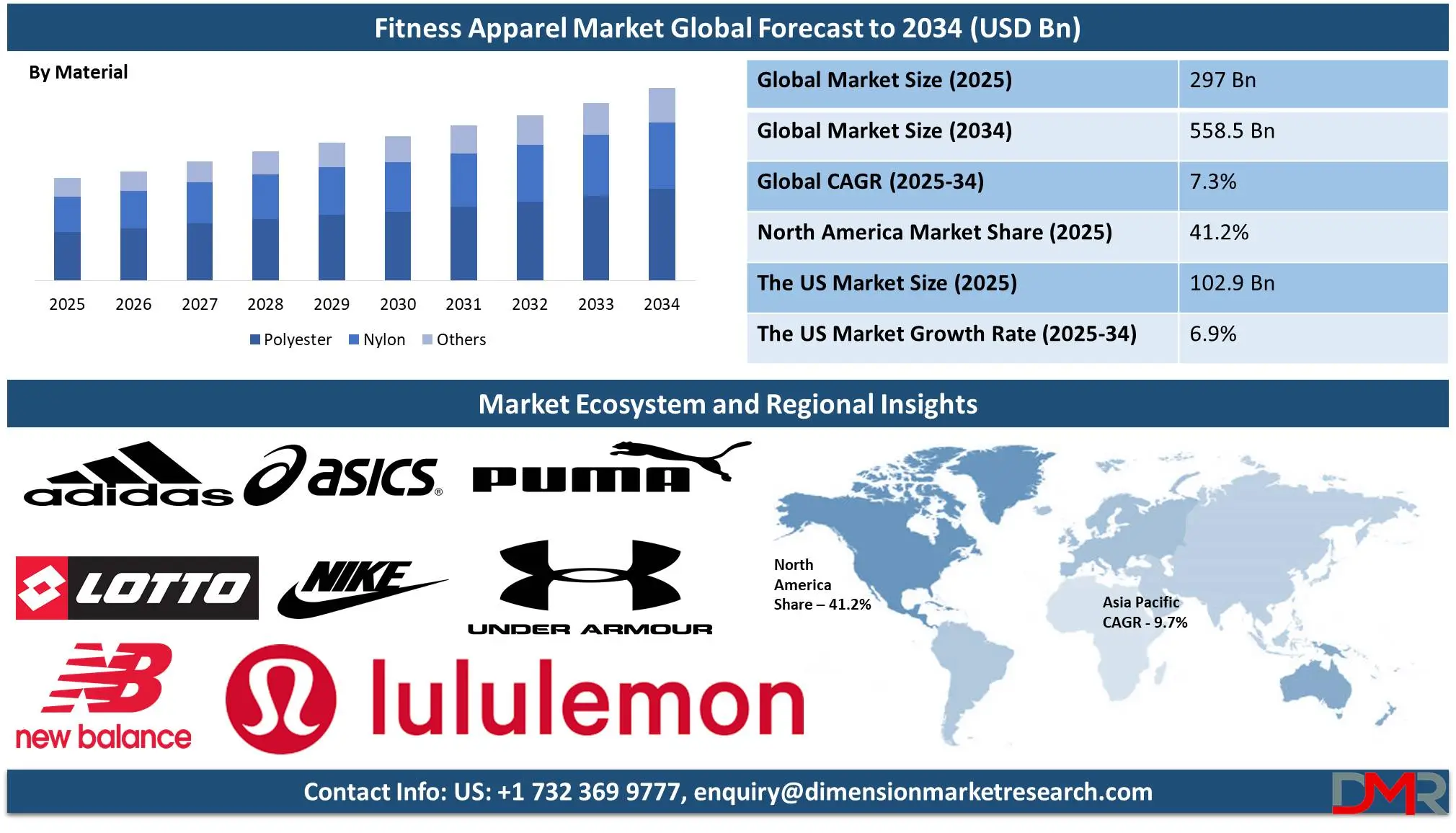
Fitness apparel is clothing designed for exercise, sports, and physical activities. These clothes are made to improve comfort, performance, and durability during workouts or athletic activities. Popular items like leggings, sports bras, shorts, tank tops, t-shirts, and specialized footwear. These garments are created with materials like moisture-wicking fabrics to keep sweat away, stretchy fabrics for better movement, and lightweight materials for breathability. Over time, fitness apparel has also become a part of casual, everyday fashion, blending function with style.
Further, the rapid growth over the past decade is driven by growing awareness of health and fitness. People are engaging in more physical activities like gym workouts, yoga, running, and outdoor sports, boosting the need for high-quality activewear. In addition, the growth of athletic wear, a trend where fitness wear is worn as everyday casual clothing—has further expanded the market.
Also, several trends have shaped the fitness apparel industry. Sustainability has become a major focus, with brands creating eco-friendly products using recycled or biodegradable materials. Smart fitness clothing that can monitor heart rate, calories burned, and movement is gaining traction. Personalization is another trend where consumers look for custom designs and fit. Gender-neutral activewear and inclusive sizing are also on the rise, ensuring that fitness apparel is accessible to everyone, regardless of body type or gender identity. Style-wise, bold colors, patterns, and retro-inspired designs are popular.
Also, the recent pandemic significantly impacted the fitness apparel market. With gyms and fitness centers closed, people turned to home workouts, driving the demand for comfortable and versatile activewear. Online shopping for fitness clothing has grown during this time. Major brands also adapted by launching digital campaigns and virtual fitness classes to connect with their customers. Another recent event was the focus on diversity, as brands began featuring models of different sizes, ethnicities, and abilities in their marketing campaigns, which has made the industry more inclusive.
Also, modern consumers prioritize both performance and style when choosing fitness apparel. They want clothing that not only helps their workouts but also looks fashionable enough to wear outside the gym. Comfort, durability, and affordability are critical factors. In addition, there is a growing preference for brands that are environmentally responsible and transparent about their production processes. Consumers also value innovative features like anti-odor technology, UV protection, and smart sensors embedded in active wear.
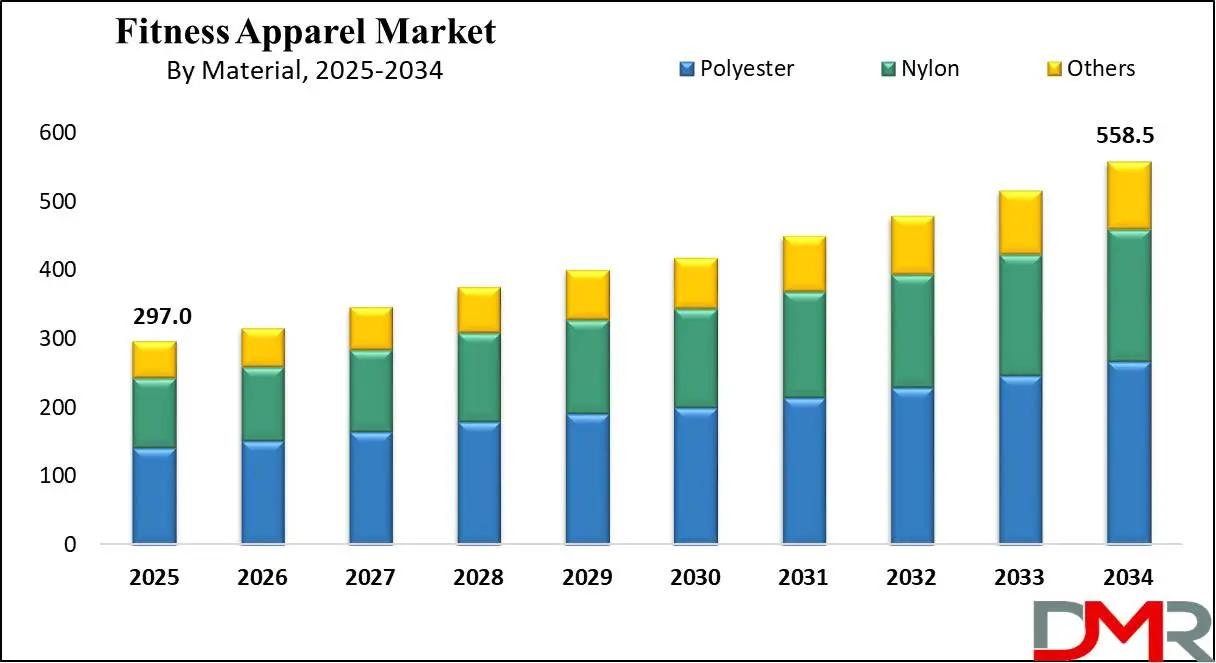
Moreover, it is expected to continue growing as health-conscious lifestyles and the athleisure trend persist. Brands that innovate, use sustainability, and provide inclusive designs will likely gain a competitive edge. The growth of wearable technology and smart clothing suggests an exciting future for fitness apparel, where function meets technology. For consumers, the focus on diversity and eco-friendliness indicates that they can expect a wider variety of choices tailored to their needs, preferences, and values.
The US Fitness Apparel Market
The US Fitness Apparel Market is projected to reach USD 102.9 billion in 2025 at a compound annual growth rate of 6.9% over its forecast period.
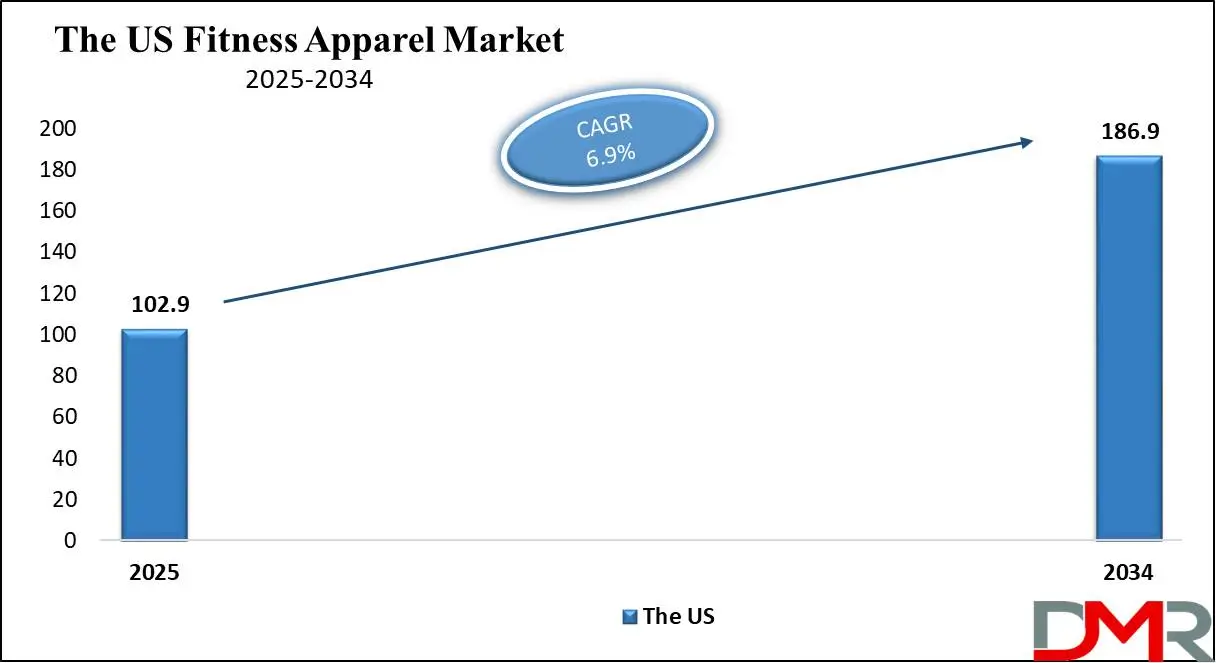
In the US, the fitness apparel market provides growth opportunities through growing health awareness, growing participation in fitness activities, and the increase in popularity of exercise. Innovation in smart clothing, sustainable materials, and personalized fitness gear also presents potential. In addition, the major use of e-commerce and fitness apps creates a bigger reach for brands to connect with health-conscious consumers.
Further, a key growth driver in the market is the growth in health consciousness and active lifestyle trends, with increasing participation in fitness activities and athleisure wear. However, restraint is the intense market competition, leading to price wars and lower profit margins. In addition, the high cost of premium materials may limit accessibility for price-sensitive consumers.
Key Takeaways
- Market Growth: The Fitness Apparel Market size is expected to grow by 242.2 billion, at a CAGR of 7.3% during the forecasted period of 2026 to 2034.
- By Material: The polyester segment is anticipated to get the majority share of the Fitness Apparel Market in 2025.
- By Type: Footwear are expected to be leading the market in 2025
- By Application: The men segment is expected to get the largest revenue share in 2025 in the Fitness Apparel Market.
- Regional Insight: North America is expected to hold a 41.2% share of revenue in the Global Fitness Apparel Market in 2025.
- Use Cases: Some of the use cases of Fitness Apparel include injury prevention, athleisure wear, and more.
Use Cases
- Enhanced Performance: Developed with moisture-wicking, stretchable, and breathable fabrics to enhance comfort and movement during workouts, sports, or outdoor activities.
- Injury Prevention: Provides proper assistance, like compression leggings or sports bras, to reduce strain, reduce muscle fatigue, and enhance recovery.
- Athleisure Wear: Versatile clothing that blends fitness functionality with casual style, making it suitable for both exercise and everyday wear.
- Technological Integration: Smart fitness apparel tracks metrics like heart rate, calories, and movement, supporting fitness goals and monitoring health in real-time.
Stats & Facts
- According to UK Fitness, 76% of UK residents aspire to be fit and healthy, but 65% feel they don’t look after their health as much as they should, showing a slight 1% improvement from last year.
- Further, 22% of the UK population doesn’t consider themselves healthy, with 27% of 45-to-54-year-olds feeling this way—the highest among all age groups. Women (24%) are also more likely than men (20%) to perceive themselves as unhealthy.
- Also, mental health and physical fitness remain key priorities in the UK, with 34% of people wanting to improve their mental health and 34% focusing on cardiovascular fitness, followed by 33% aiming to get stronger.
- As per Fitbudd, 30% of adults in the USA now engage in daily physical activities, a rise driven by growing health awareness. Younger adults (18-34) lead with 40% participating, followed by 35% of middle-aged adults (35-54), and 25% of seniors (55+), reflecting a positive trend across all demographics.
- Moreover, men (32%) in the USA are slightly more active than women (28%) in daily exercise, but the gap is narrowing as more women adopt fitness routines (Source: Fitbudd).
- In addition, walking is the most popular form of exercise, chosen by 60% of active adults. Strength training is following, and it is gaining popularity, with 25% incorporating it into their routines.
- Also, fitness apps and wearables are transforming how people exercise in the USA, with 45% of active adults using apps to track progress and 35% relying on devices like smartwatches to monitor health metrics.
- According to the International Health, Racquet & Sportsclub Association (IHRSA), gym memberships in the USA reached a record 64.2 million in 2023, reflecting robust growth in the gym industry.
- Further, the Sports & Fitness Industry Association (SFIA) reported that running and jogging remain favorite activities among fitness enthusiasts, with 60 million Americans participating annually, while yoga and Pilates are seeing rising popularity, with over 20 million practicing yoga regularly.
- Also, as per The National Sporting Goods Association (NSGA) reports, basketball and swimming rank among the most popular sports in the USA and are enjoyed recreationally and competitively by millions.
Market Dynamic
Driving Factors
Rising Health and Fitness AwarenessWith increasing awareness about the importance of a healthy lifestyle, more people are engaging in physical activities like gym workouts, yoga, and outdoor sports. This has driven demand for functional, comfortable, and performance-enhancing fitness apparel. Social media and influencers promoting active lifestyles have further accelerated this trend. Additionally, post-pandemic health concerns have encouraged more individuals to invest in workout gear for home exercises. The growing global emphasis on wellness is a key driver for the market’s expansion.
Athleisure and Fashion Trends
The growth of athleisure fitness apparel as everyday casual wear—has majorly expanded the market. Consumers prefer stylish yet functional clothing that transitions smoothly from workouts to daily activities. Brands are innovating with trendy designs, bold patterns, and sustainable materials to meet this demand. The growth in preference for comfort-driven fashion has attracted a broader audience, including non-athletes. This fusion of fitness and fashion continues to boost sales and drive growth in the fitness apparel industry.
Restraints
High Cost of Premium Fitness Apparel
The high cost of quality fitness apparel, mainly those with advanced features like moisture-wicking fabrics, smart sensors, or eco-friendly materials, can affect price-sensitive consumers. Budget-conscious individuals often opt for cheaper alternatives, which impacts sales for premium brands. In addition, fluctuating raw material costs and labor expenses can drive up prices, making fitness apparel less accessible, which is mainly significant in developing markets with lower purchasing power. As a result, it limits the market's potential customer base.
Intense Market Competition
The fitness apparel industry is highly competitive, with various global and regional players offering similar products, which creates challenges for new entrants and smaller brands to establish a foothold. Larger companies dominate through aggressive marketing, brand loyalty, and economies of scale, leaving little room for differentiation. In addition, counterfeit or low-quality products on the market can dilute brand reputation and affect consumer trust, which often results in price wars, squeezing profit margins for businesses.
Opportunities
Growing Demand for Sustainable and Eco-Friendly Apparel
The growing awareness of environmental issues provides an opportunity for brands to focus on sustainable fitness apparel. Consumers are looking for products made from recycled materials, organic fabrics, and eco-conscious production processes. By adopting sustainability as a core value, companies can attract environmentally-conscious buyers & differentiate themselves from competitors. Certifications & transparency about the supply chain can further boost consumer trust, which is a growing trend that brands can leverage to gain market share.
Emerging Markets and Digital Expansion
The fitness apparel market has immense growth potential in emerging economies, where the growth of disposable incomes and health awareness are driving the demand. Brands can capitalize on these untapped markets through localized marketing strategies & affordable product lines. In addition, the rapid expansion of e-commerce platforms allows companies to reach global audiences more effectively. Virtual try-on features, personalized recommendations, and online fitness communities can improve customer engagement, which opens new opportunities for growth in both established and emerging markets.
Trends
Rise of Smart and Tech-Integrated Apparel
Fitness apparel with built-in technology, like sensors to track heart rate, calories burned, and movement patterns, is gaining popularity. These smart garments meet tech-savvy consumers looking for real-time data to enhance their workouts and health. Wearable technology combined with fitness clothing adds convenience and functionality, making it an ideal choice for performance-focused users. Brands are highly investing in R&D to integrate advanced features, which bridge the gap between fitness, fashion, and technology.
Inclusivity in Sizing and Design
The fitness apparel industry is transforming towards inclusivity, providing extended size ranges and gender-neutral options to meet a diverse audience. Brands are creating designs that accommodate different body types and prioritize comfort without compromising style. Marketing campaigns now feature models of different sizes, ethnicities, and abilities, reflecting a broader consumer base, which not only promotes body positivity but also opens up the market to earlier underserved demographics. Inclusivity is becoming a key driver of brand loyalty and growth.
Research Scope and Analysis
By Type
In 2025, footwear will play a vital role in the growth of the fitness apparel market and is expected to lead in terms of revenue share by offering the support, comfort, and functionality needed for different physical activities. Whether it’s running, gym workouts, or outdoor sports, the right footwear minimizes the risk of injury, enhances performance, and improves overall comfort. The rising interest in fitness and wellness has increased demand for activity-specific shoes like running sneakers, cross-trainers, and yoga slip-ons.
Innovations such as lightweight materials, advanced cushioning, and breathable designs further attract consumers. In addition, the growing popularity of athletic footwear has led to stylish sports footwear being worn casually, enhancing its appeal. Post-pandemic, more people have invested in fitness shoes for both home and outdoor exercises, making footwear a key growth driver in the fitness apparel market.
Further, outerwear, like jackets, hoodies, and sweatshirts, are set to contribute significantly to the growth of the fitness apparel market in the forecast years by providing functionality and style. Designed for outdoor activities, these garments protect against weather conditions like rain, wind, or cold, making them vital for running, hiking, or training outdoors. With features like water resistance, breathability, and lightweight materials, fitness outerwear meets both performance and comfort needs. Its versatility also boosts demand, as many use it for casual, everyday wear.
By Material
Based on material, polyester will lead the fitness apparel market in 2025 due to its durability, lightweight nature, and moisture-wicking properties, which are highly resistant to wear and tear, making it ideal for activewear that endures intense workouts and repeated use. Polyester’s ability to wick sweat away from the body keeps wearers dry and comfortable, improving performance during exercise. Its quick-drying feature is mainly valued for outdoor and high-intensity activities. In addition, polyester blends easily with other fabrics like spandex, adding stretch and flexibility to fitness apparel. Innovations in recycled polyester are also driving growth, appealing to eco-conscious consumers. Also, affordable production costs further make it a popular choice for manufacturers, contributing to the widespread availability of functional and stylish fitness apparel.
Further, nylon is also a key material in the growth of the fitness apparel market due to its strength, flexibility, and lightweight feel. Known for being durable and resistant to abrasions, it’s perfect for activewear that withstands rigorous workouts. Nylon also dries quickly & wicks moisture, keeping wearers comfortable during exercise. Its soft texture adds to its appeal, and its versatility makes it ideal for many fitness clothing like leggings, tops, and sports bras.=n
By Sales Channel
Offline sales channels, like retail stores, specialty shops, and brand outlets are anticipated to lead the fitness apparel market in 2025 by providing a hands-on shopping experience. Many customers look into trying on fitness clothing to ensure the right fit, comfort, and quality before purchasing. Physical stores also provide customized customer service, supporting buyers in making informed decisions about materials, designs, and functionality. In addition, they often host promotional events, exclusive collections, and discounts, which attract shoppers and build brand loyalty.
Also, these stores allow brands to showcase their latest innovations and build a direct connection with their audience. Despite the growth of online shopping, offline outlets remain important, mainly in regions where e-commerce penetration is low. They look into customers who value in-store experiences, contributing to the overall expansion of the fitness apparel market.
Further, online sales channels have significantly boosted the growth of the fitness apparel market and are expected to grow significantly in the coming years by offering convenience, variety, and accessibility. E-commerce platforms allow customers to shop anytime, compare prices, and access a variety of styles and brands. Features like virtual try-ons, customized recommendations, and easy returns improve the shopping experience. Online sales also allow brands to reach a global audience, making it easier for consumers in remote areas to access fitness apparel.
By Application
In terms of application, the men's segment is projected to lead the fitness apparel market in 2025, as more men prioritize fitness and look for active lifestyles. Growing participation in gym workouts, running, sports, and outdoor activities has driven the need for performance-driven activewear. Men typically look for durable, functional, and comfortable clothing, like moisture-wicking t-shirts, compression wear, and flexible shorts, designed to improve physical performance.
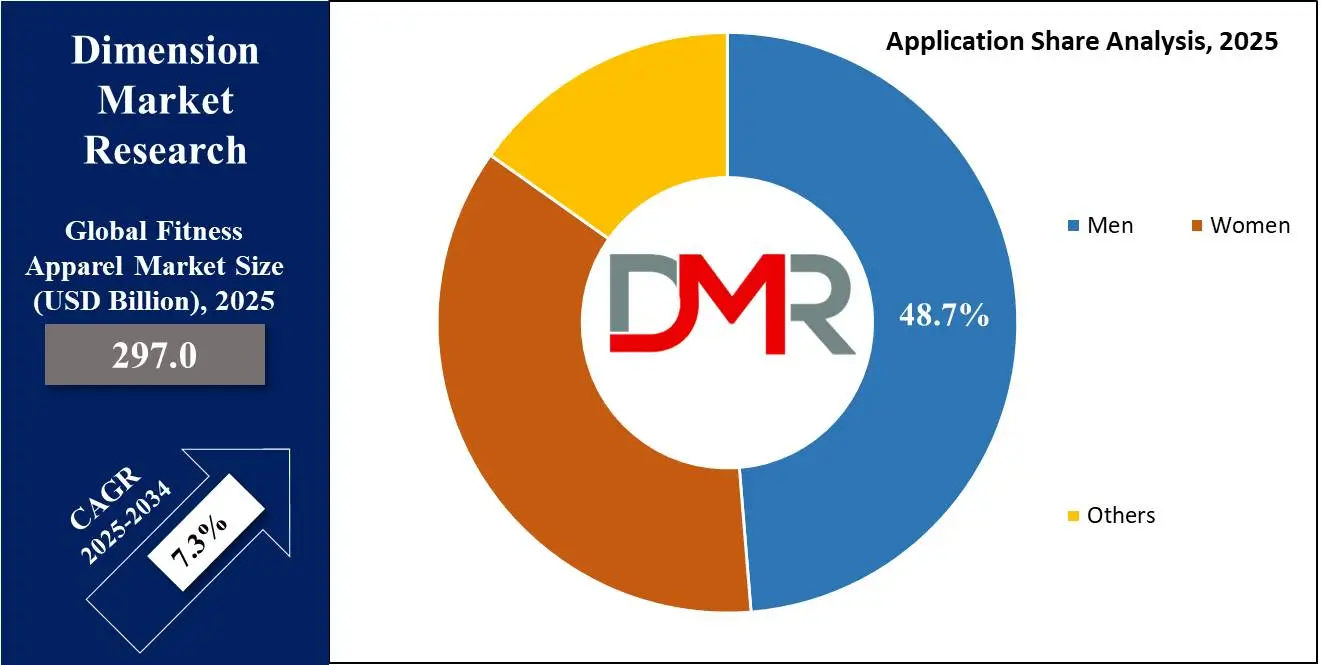
In addition, the growing popularity of athleisure has made fitness apparel a preferred choice for casual wear, enhancing its appeal among men. Social media and fitness influencers have further made men invest in stylish, high-quality activewear. Brands are responding with innovative designs and materials customized for men’s fitness needs, driving both sales and market growth, which among men continues to shape the global fitness apparel industry positively.
Further, the women segment is also set to a crucial role in the growth of the fitness apparel market during the forecasted years as the rise in the numbers of women engaging in fitness activities like yoga, running, and gym workouts rises. They look for stylish, comfortable, and functional activewear, driving the demand for leggings, sports bras, and tops. The rise of athleisure has further expanded women’s interest in fitness apparel, making it a daily wardrobe staple.
The Fitness Apparel Market Report is segmented on the basis of the following
By Type
- Swimwear
- Footwear
- Outerwear
- Other
By Material
By Sales Channel
By Application
Regional Analysis
North America is set to lead the fitness apparel market in 2025 with a
share of 41.2% owing to its strong focus on health, wellness, and fitness culture. The region has seen a significant rise in gym memberships, outdoor activities, and sports participation, driving demand for performance-oriented apparel. With an increase in the population of health-conscious individuals, consumers are highly investing in high-quality fitness clothing to support their active lifestyles.
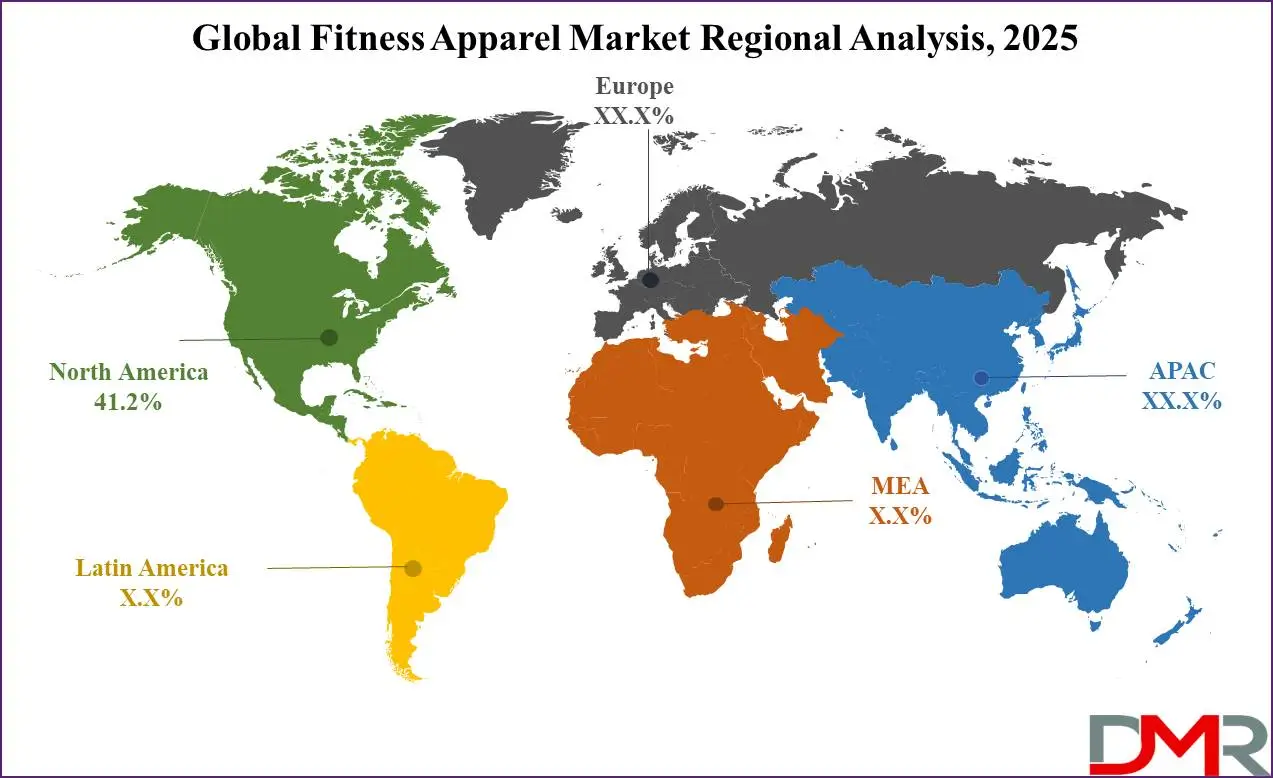
The popularity of athleisure wear, combining style and functionality, has also driven market growth, as people wear fitness apparel not only for workouts but also for everyday activities. In addition, the region is home to major fitness apparel brands, leading innovation in fabric technologies, sustainability, and design, as the strong retail infrastructure, like both physical stores and a strong e-commerce presence, ensures easy access to fitness apparel. The major focus on wellness and fitness events and a growing interest in wearable tech further contribute to North America’s dominance in the global market.
Further, Europe will also have a significant share in 2025 in the growth of the fitness apparel market, driven by a growing focus on health and wellness. With the rise in participation in sports & fitness activities and the major trend of athleisure, the need for stylish and functional activewear is growing. European consumers prioritize sustainability, pushing brands to innovate with eco-friendly materials and production methods.
Moreover, Asia Pacific is anticipated to experience rapid growth in the fitness apparel market in the coming years, driven by an increase in health awareness, growing disposable income, and a rise in interest in fitness activities. The region’s young, tech-savvy population is also embracing athleisure and online shopping trends.
By Region
North America
Europe
- Germany
- The U.K.
- France
- Italy
- Russia
- Spain
- Benelux
- Nordic
- Rest of Europe
Asia-Pacific
- China
- Japan
- South Korea
- India
- ANZ
- ASEAN
- Rest of Asia-Pacific
Latin America
- Brazil
- Mexico
- Argentina
- Colombia
- Rest of Latin America
Middle East & Africa
- Saudi Arabia
- UAE
- South Africa
- Israel
- Egypt
- Rest of MEA
Competitive Landscape
The fitness apparel comprises numerous global and regional brands offering numerous products. Companies focus on innovation, utilizing advanced materials like moisture-wicking fabrics, breathability, and durability to meet the demands of active consumers. Athleisure, blending style with functionality, is gaining popularity, promoting brands to create versatile clothing suitable for both workouts and casual wear. Intense competition is also driven by price sensitivity, brand loyalty, and the growth of online retail. In addition, sustainability has become a key differentiator, with many companies adopting eco-friendly materials and production practices to appeal to conscious consumers.
Some of the prominent players in the Global Fitness Apparel are
- Nike
- Adidas
- New Balance
- Puma
- Under Armour
- LOTTO
- Lululemon
- Anta
- Asics
- Gymshark
- Other Key Players
Recent Developments
- In December 2024, Lagree Fitness launched its first-ever apparel line for women, where each piece is designed to enhance one's Lagree workout while also serving a purpose for everyday wear beyond the studio. The elevated line is built with premium materials, providing a luxurious look and feel without compromising on comfort, while including a wide variety of sleek and stylish options ranging from sports bras to hoodies.
- In August 2024, Firm abs launched three innovative collections as part of its Fall 2024 lineup.A s part of its Fall 2024 lineup, Firm abs launched three exciting collections that build upon its legacy of innovation, namely as The Faux Leather Biker Series "Race Queen", The Cargo Collection, and The Firm abs Philosophy.
- In March 2024, Dillard’s, Inc. launched Katherine Mason for Kinesis, which is made available in Dillard’s locations across the nation and online at dillards.com. Designed by fitness & fashion expert and entrepreneur, Kthe collaboration offers coordinating athleisure and performance pieces with Kinesis, the company’s exclusive line of ladies’ active and athleisure wear.
- In January 2024, CALIA introduced a new national ad campaign titled "CALIA Inspire: There's Beauty in the Burn" to assist the brand's most versatile and technically designed fabric and apparel collection to date, named Inspire, which includes a wide range from a low-intensity yoga session to high-intensity weight training, at home and beyond.
Report Details
| Report Characteristics |
| Market Size (2024) |
USD 297.0 Bn |
| Forecast Value (2033) |
USD 558.5 Bn |
| CAGR (2024-2033) |
7.3% |
| Historical Data |
2018 – 2023 |
| The US Market Size (2024) |
USD 102.9 Bn |
| Forecast Data |
2025 – 2033 |
| Base Year |
2023 |
| Estimate Year |
2024 |
| Report Coverage |
Market Revenue Estimation, Market Dynamics, Competitive Landscape, Growth Factors and etc. |
| Segments Covered |
By Type (Swimwear, Footwear, Outerwear, and Others), By Material (Polyester, Nylon, and Others), By Sales Channel (Online and Offline), By Application (Men, Women, and Others) |
| Regional Coverage |
North America – The US and Canada; Europe – Germany, The UK, France, Russia, Spain, Italy, Benelux, Nordic, & Rest of Europe; Asia- Pacific– China, Japan, South Korea, India, ANZ, ASEAN, Rest of APAC; Latin America – Brazil, Mexico, Argentina, Colombia, Rest of Latin America; Middle East & Africa – Saudi Arabia, UAE, South Africa, Turkey, Egypt, Israel, & Rest of MEA
|
| Prominent Players |
Nike, Adidas, New Balance, Puma, Under Armour, LOTTO, Lululemon, Anta, Asics, Gymshark, and Other Key Players |
| Purchase Options |
We have three licenses to opt for: Single User License (Limited to 1 user), Multi-User License (Up to 5 Users) and Corporate Use License (Unlimited User) along with free report customization equivalent to 0 analyst working days, 3 analysts working days and 5 analysts working days respectively. |
Frequently Asked Questions
The Global Fitness Apparel Market size is expected to reach a value of USD 297.0 billion in 2025 and is expected to reach USD 558.5 billion by the end of 2034.
North America is expected to have the largest market share in the Global Fitness Apparel Market with a share of about 41.2% in 2025.
The Fitness Apparel Market in the US is expected to reach USD 102.9 billion in 2025.
Some of the major key players in the Global Fitness Apparel Market are Nike, Adidas, New Balance, and others
The market is growing at a CAGR of 7.3 percent over the forecasted period.